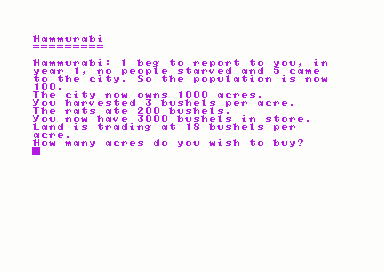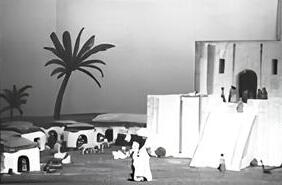Welcome to the ancient city of Sumeria, where you step into the sandals of Hammurabi, the administrator tasked with the monumental challenge of managing this thriving metropolis. In Hammurabi C64: City Management Simulation, you'll navigate the delicate balance between resource allocation, population growth, and unforeseen challenges in a game that immerses you in the complexities of ancient civilization.
Who is Hammurabi
Hammurabi was a Babylonian king who ruled from about 1792 to 1750 BC. He is best known for the legal code that bears his name, the Code of Hammurabi, one of the earliest and most complete written legal systems in recorded history. This code consisted of 282 laws covering various aspects of Babylonian society, including criminal, civil, and commercial matters. Hammurabi's code is often studied for its influence on later legal systems and its insights into the social structure and values of ancient Mesopotamia. Hammurabi also expanded Babylon's influence and power during his reign, making it one of the great powers of the ancient Near East.
Hammurabi C64 Gameplay
When the game begins, you're presented with a modest city consisting of 1,000 acres of land, 100 inhabitants, and a stockpile of 3,000 bushels of grain. Your primary currency is grain, which you use not only to trade with neighboring city-states, but also to feed your people and sow the seeds for future harvests.
The core gameplay mechanic of the Hammurabi C64 retro game revolves around strategic decisions regarding land transactions. Will you expand your city's territory by purchasing additional land from neighboring city-states, or will you prioritize maintaining a steady supply of grain to feed your population? Dynamic land pricing, ranging from 17 to 26 bushels per acre, adds an element of risk and reward to your economic endeavors.
 Managing your city, however, goes beyond mere transactions in the Hammurabi C64. You must also deal with the intricacies of agricultural productivity and population dynamics. Balancing the number of workers with the amount of arable land becomes a critical factor in maximizing efficiency while mitigating the risk of famine. Failure to adequately feed your citizens or plan for future harvests can have dire consequences, including starvation and population decline.
Managing your city, however, goes beyond mere transactions in the Hammurabi C64. You must also deal with the intricacies of agricultural productivity and population dynamics. Balancing the number of workers with the amount of arable land becomes a critical factor in maximizing efficiency while mitigating the risk of famine. Failure to adequately feed your citizens or plan for future harvests can have dire consequences, including starvation and population decline.
In addition, the game introduces a myriad of unexpected challenges that will test your adaptability and resilience as a ruler. From plagues sweeping through the city to rats decimating stored grain supplies, you must navigate these crises with ingenuity and resourcefulness. Variable harvests add to the complexity of your decisions, forcing you to anticipate and mitigate the effects of seasonal fluctuations on your city's prosperity.
What sets Hammurabi C64 City Management Simulation is its realistic portrayal of the complexities inherent in governing an ancient civilization. Over the course of ten simulated years, you'll witness the gradual development of your city and experience firsthand the ebb and flow of prosperity and adversity. The game's historical accuracy is underscored by its origins; originally written as a simplified version of The Sumerian Game in Focal at DEC by Doug Dyment in 1968, David Ahl converted it to BASIC and added a 10-year performance evaluation feature.
 The C64 iteration of Hammurabi is the same simplified rendition of The Sumerian Game, a pioneering precursor to the city-building genre and an early example of strategic gaming. Originally conceived in 1964 by fourth-grade teacher Mabel Addis and brought to life by programmer William McKay for the IBM 7090 time-sharing mainframe, The Sumerian Game emerged during the formative years of video game development and served as a catalyst for numerous innovations within the medium. In particular, it is credited with laying the groundwork for both strategy and city-building games, while also earning the distinction of being the first video game to incorporate a narrative element and blend entertainment with educational content, establishing itself as an early example of edutainment. Mabel Addis's pivotal role as a female video game designer and writer further underscores the game's significance in gaming history.
The C64 iteration of Hammurabi is the same simplified rendition of The Sumerian Game, a pioneering precursor to the city-building genre and an early example of strategic gaming. Originally conceived in 1964 by fourth-grade teacher Mabel Addis and brought to life by programmer William McKay for the IBM 7090 time-sharing mainframe, The Sumerian Game emerged during the formative years of video game development and served as a catalyst for numerous innovations within the medium. In particular, it is credited with laying the groundwork for both strategy and city-building games, while also earning the distinction of being the first video game to incorporate a narrative element and blend entertainment with educational content, establishing itself as an early example of edutainment. Mabel Addis's pivotal role as a female video game designer and writer further underscores the game's significance in gaming history.
 Although the original code for The Sumerian Game has been lost to time, its legacy lives on through the 2012 discovery of projector slides and three printed The Sumerian Game sessions, which were generously donated to the Strong National Museum of Play's Brian Sutton-Smith Library and Archives of Play, ensuring its preservation for future generations of gamers and historians alike.
Although the original code for The Sumerian Game has been lost to time, its legacy lives on through the 2012 discovery of projector slides and three printed The Sumerian Game sessions, which were generously donated to the Strong National Museum of Play's Brian Sutton-Smith Library and Archives of Play, ensuring its preservation for future generations of gamers and historians alike.
In conclusion, "Hammurabi C64" offers a compelling and immersive gaming experience that challenges players to navigate the intricacies of ancient city management. Whether you're a history buff or a strategy aficionado, this game promises hours of engaging gameplay as you strive to lead Sumeria to greatness under the wise leadership of Hammurabi.
Hammurabi C64 Links
- Hammurabi C64 game download link
- Hammurabi C64 in C Github page
- Related pages of the Hamurabi in David Ahl's Book














